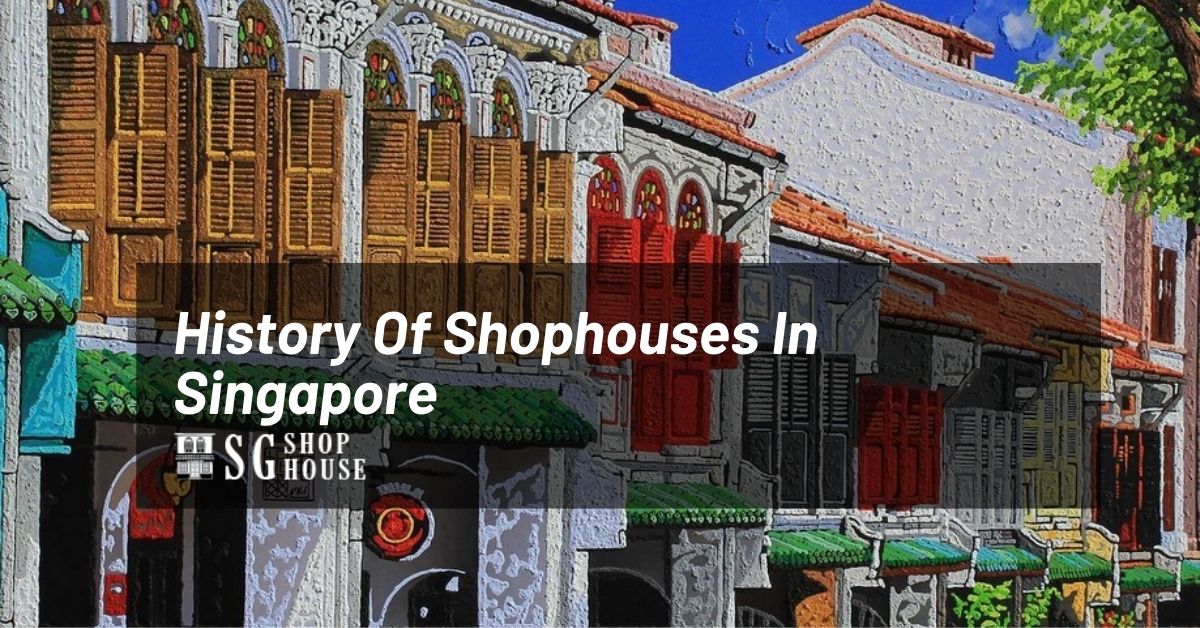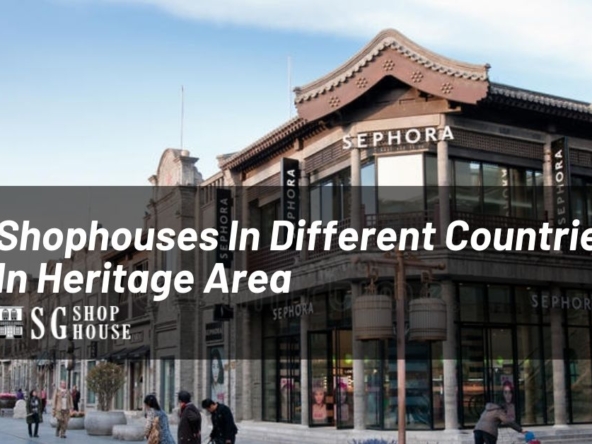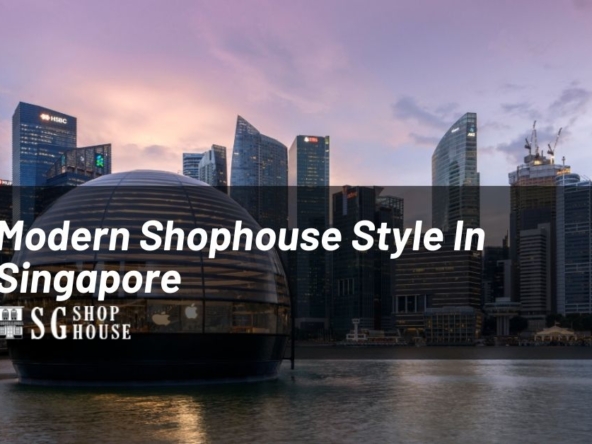What are shophouses?
They were built by Singapore’s pioneers and showcased the many cultural influences of the early builders who bought land from the East India Company. They were built for sale or rented to new immigrants seeking their fortunes. From the 1840s to the 1960s, shophouses moved through many different styles, from the Early and
Late Shophouse to the Art Deco and Modern Shophouse. These traced Singapore’s evolution from a trading port into a city as they moved from their glorious early days to a deteriorated congested state. With the conservation efforts of owners, many of them have been rejuvenated today. In this article, you will get to know in detail about the History Of Shophouses In Singapore.
A Little History of Shophouses
History Of Shophouses: Shophouses are a part of Singapore’s colonial history, stretching all the back to the 18th century. As Singapore started to grow in the 1960s, many Shophouses flattened for new developments. Understanding the importance of conserving some of its heritage, the 1970s and the start of the 1980s saw a change in policy. State-owned shophouses along Murray Street and Tudor Court were renovated and restored to their original state which brought with it a change in perception as to the value of these pre-war buildings.
The 1980s brought with it a renewed interest in preservation and conservation. A good example is the pedestrianization of Emerald Hill Road in 1981. In 1986 the URA unveiled their Conservation Master Plan to renovate and restore Singapore’s historical areas. Starting with 9 Neil Road in 1987, it was a catalyst for increased restoration of Shophouses throughout the Tanjong Pagar precinct and other areas too.
Heading towards the late 1980s, over 3200 building earmarked for conservation in 10 historical districts across Singapore. The districts were: Chinatown (Telok Ayer, Kreta Ayer, Tanjong Pagar, and Bukit Pasoh), Little India, Kampong Glam, Singapore River (Boat Quay and Clarke Quay), Cairnhill and Emerald Hill. To date, conservation status has been given to over 7000 buildings in more than 100 areas.
History Of Shophouses: Singapore Shophouse
Shophouses first appeared in Singapore when the Town Plan of Sir Stamford Raffles dictated the subdivision of the land into smaller regular lots. They were narrow, long terrace houses with varied facades, creating an attractive unified streetscape. The shophouse built to be flexible, either to use entirely as a home or a home upstairs with a shop downstairs. It can think of as the original ‘home office’!
The conservation guidelines for shophouses and terrace houses relate to the key elements of the typology of the building. Constructed between 1840 and 1960, these simple buildings are two- to three-storeys high, built-in contiguous blocks with common party walls. The design and material of the shophouses and terrace houses vary according to the architectural style of the building. Singapore shophouses fall into six styles. They are the Early Shophouse, the First Transitional Shophouse, the Late Shophouse, the Second Transitional Shophouse, the Art Deco Shophouse, and the Modern Shophouse.
Shophouse Styles
History Of Shophouses: Through the years, shophouse styles evolved to reflect the changing needs, influences, and prosperity of the country and its people. According to the Urban Redevelopment Authority (URA), shophouses in Singapore can be categorized into six architectural styles. Each style had a set of defining characteristics influenced by trends of the era.
The origins of the Singapore shophouse trace back to China, particularly the Guangdong and Fujian provinces where a majority of early immigrants to Singapore came from. The first shophouses, known stylistically as the Early Shophouse Style (1840s-1900s), were constructed during the mid-1840s at the southern end of the Singapore River along South Bridge and New Bridge Road. Such houses would lay the foundations for the various styles that would develop in the years to come.
1.Early Shophouse Style (1840-1900)
This style is typified by a low and squat two-storey building with one or two windows on the upper floor façade. The rectangular windows and doors are timber-framed with shutters of boards, panels, or louvres to aid ventilation. It is characterized by minimal ornamentation, usually of an ethnic nature.
2.First Transitional Shophouse Style (Early 1900s)
Windows and doors are usually timber-shuttered although small plates of glass in the shutters became increasingly common. There are often two windows on the upper storeys and transoms are flat-arched or semi-circular. Vents are squares or diamonds between windows. In line with Singapore’s growing affluence, the First Transitional Shophouse Style projects a lighter expression and is more vertically proportionate than its predecessor. Decorations using plaster and tiles used, while the addition of small glass panels into the windows became increasingly common. A trademark of First Transitional shophouses is their elegant simplicity and relatively restrained ornamentation.
3.History Of Shophouses: Late Shophouse Style (1900-1940)
This is the most spectacular style, particularly in its extensive use of decorative moldings, pilasters, carved wood-work, and imported glazed tiles on the facade. The design and craftsmanship represent a successful fusion of the East and West in architecture. Often hailed as the most spectacular and vibrant of all shophouses, the Late Shophouse Style displays striking, varied, and eclectic ornamentation, such as decorative wall tiles, framing of windows with columns and pilasters, as well as the introduction of cultural influences such as roof eaves (Malay) and decorative tiles (Peranakan) to the building. After the late style, there was a move towards simpler ornamentation and a more streamlined design that culminated in the Art Deco Shophouse Style.
4.Second Transitional Shophouse Style (Late 1930s)
This has a simple and streamlined design as the designers and builders began to simplify the ornamentation.
Late style motifs such as ornately carved transoms and colorful ceramic tiles often combined with Art Deco
elements such as cross-braced glass window panels and simple geometric balustrade designs. Bridging the Late and Art Deco Styles is the Second Transitional Shophouse Style, with mixes some Late Style decorative elements (such as wall tiles) with Art Deco motifs (such as geometric designs). Simple and streamline were two key components of this style, reflecting the economic situation of the time. The beginnings of Art Deco elements such as cross-braced glass window panels start to emerge.
5.History Of Shophouses: Art Deco Shophouse Style (1930s-1960s)
The Art Deco Shophouse Style distinguished by streamlined motifs (such as column orders, arches, and keystones) and the lesser use of decorative wall tiles. Often, this style of shophouse emphasizes proportion and composition of an entire grouping of similar buildings, with a special focus on the street corners. A typical feature of the Art Deco Shophouse Style is a visible plaque bearing the date of the building’s construction. Hallmarks of this style are the simple geometric design on the facade. It is also typified by the streamlining of classical motifs such as capitals, arches, and keystones.
6.Modern Shophouse Style (1950s-1960s)
As the Modern Shophouse Style emerged, elements from earlier styles began to omit. The five-foot way and party walls remained, but modern materials such as concrete used. In line with the international move towards a more utilitarian perspective at that time, modern shophouses were built to be functional and austere. The Modern Shophouse Style’s façade features thin concrete fins and air vents (as decoration) alongside mild steel windows and flat roofs to complement its geometric façade. This features the innovative use of very thin concrete fins and air vents on the building facade that are functional as well as decorative. The windows well proportioned and complement the geometric design of the facade.
History Of Shophouses: Key Elements of a Shophouse
Shophouses share certain defining features, no matter the era they built-in. Here are some of their key elements.
1.The Five-Foot Way
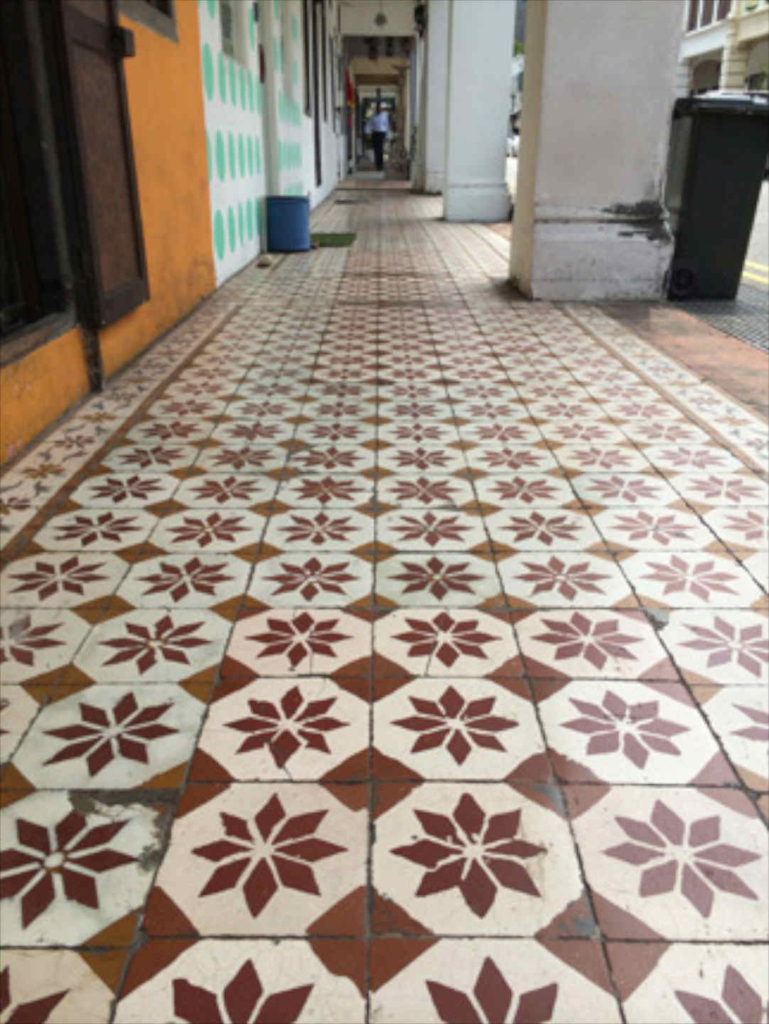
The upper storey of a shophouse supported by columns. It protruded forward to create a covered porch in front of the shop. The neighboring units similarly built, and stood side-by-side, separated by party walls. Together, they formed a continuous covered path quintessentially known as the “five-foot way.” It so-named because that was the minimum width regulated by Sir Stamford Raffles in his town plan for the fledgling settlement of Singapore. Five-foot ways were always a bustling area full of activity. Street barbers, cobblers, and numerous other vendors and hawkers would ply their trade here. In fact, this often congested the five-foot ways and streets outside, sometimes even leading to chaos and conflict amongst the merchants and with the authorities.
2.The Shop
History Of Shophouses: The front room on the ground floor would open up directly to the five-foot way and street. Merchants would display their merchandise on shelves and cabinets within. More often than not, however, their wares usually spilled out onto the five-foot way as well. Chinese merchants would inscribe the name of their business in large Chinese characters on a wooden signboard over the door.
3.History Of Shophouses: The Sky well
A sky well, or airwell, is a little patch of open space inside the shophouse for letting in light and ventilation. Before air-conditioning, this was a very effective way of cooling the interior whilst the warm, humid Singapore weather blazed outside. This concept was a key feature in traditional Chinese architecture. The rich often used the sky well as a fountain or fishpond as well, feeding-in rainwater directly from the roof. For example, the Chinese consider fish and flowing water to be auspicious. Also, such sky wells were a spot of tranquility from the bustling streets.
4.The Rear Court
The rear court was an open space at the back of the shophouse on the lower level. In the early days, it functioned as a service area and usually where the outhouse situated.
5.History Of Shophouses: The Windows
On the upper storeys of a shophouse, the windows were either French full-length windows with internal railings or casement windows with timber shutters. Earlier shophouse styles featured simple windows without much embellishment. Later on, however, shophouse owners added more decorative elements to the windows as well.
6.Floor Tiles
The ground floor of shophouses and their five-foot ways usually paved with terracotta square tiles. However, wealthier neighborhoods had Victorian-style tiles manufactured in Europe. These boasted much more elaborate geometric and floral patterns.
A glimpse of History Of Shophouses: The Shophouses in Singapore Back
1.Chinese Style Shophouse – Circa1880-1900
The earliest kind of shophouse embellishment involved mainly traditional Chinese decorative elements. It took the form of stucco reliefs and painted decorative panels depicting traditional themes and auspicious characters. Such as flowers, fruits, birds, acts of filial piety, scenes from folk tales, literature, and Chinese opera. Chinese style canopy roof over the verandah was another popular feature. Besides, they were typically surmounted by a decorative frieze comprising a mosaic of colored ceramic shards cemented. Also known as “chien mien”, meaning literally “to cut and paste”.
2.Chinese Baroque Style Shophouse – 1895-1910
By the turn of the 19th century, these Chinese decorative features superseded by European Classical elements.
What has come to be known as the “Chinese Baroque shophouse”. Besides, it represents one of the high watermarks of shophouse architecture. European influences first begin to make an appearance in the shophouse in the form of Classical details lifted from colonial architecture. For example, Doric pilaster at the ground floor level, Ionic pilaster for the floor above. Also, Corinthian pilaster for the upper storey.
This basic configuration rapidly developed, reinvented by local Singaporean architects. The end result was a very singular style of architecture. The spirit of inventiveness, the richness of embellishments, and the reinterpretation of the Classical repertoire is quintessentially Baroque. Hence, we can refer to this style of architecture as Chinese Baroque.
3.Rococo Style Shophouse – 1916-1929
It wasn’t long before the shophouse façade literally erupted into a dazzling display of surface ornamentation.
Fluted pilasters surmounted by Corinthian capitals divided up the façade into bays, while elaborate architraves framed the window openings. The Classical repertoire gave local artisans plenty of scope for their creative imaginings. For example, swags and garlands, festoons and medallions, egg-and-dart, and acanthus leaves were all joyfully seized upon and reproduced. The general idea is to cover every square inch of the façade with as much ornamentation as possible. It was like a mixture of coral, seaweed, scallop-shells, and stylized foliage. The Classical influence morphed into a kind of “wedding cake” style of architecture that put even the Baroque style in the shade. Ultimately Rococo is probably the more appropriate term.
4.History Of Shophouses: Chinoiserie 1920s
This era, characterized by this high interest in surface ornamentation will end in apotheosis with the Rococo Chinoiserie. In the 1920s, there was a revival of enthusiasm for traditional Chinese imagery with shophouse façades almost overwhelming in some instances by a profusion of animal and plant motifs. As an ensemble, this riot of surface ornamentation was quite extraordinary. For example, these Chinese decorative elements include flowers, vases with peonies, birds, cranes, peacocks, bats, dragons, phoenixes. The 12 animals of the Chinese zodiac. Each with its own auspicious significance. The Rococo style remained in vogue until the end of the 1920s. It is at which point in time it began to overtake by more modern influences. Besides, the rise of suburbs between the wars saw the introduction of a more subdued Rococo style. The style which at times bordered on the Neo-Classical.
5.Blair Plain Refined Rococo Style – 1920s
In the interwar years, there was one small area that lent itself to residential development. That was the neighborhood known today as Blair Plain – Spottiswoode Park, Everton Road, and Blair Road. Most of the houses on Blair Plain date from the early 1920s. Together they constitute some fine example of the more refined Rococo townhouse style.
6.East Coast Peranakan Style – 1920-1935
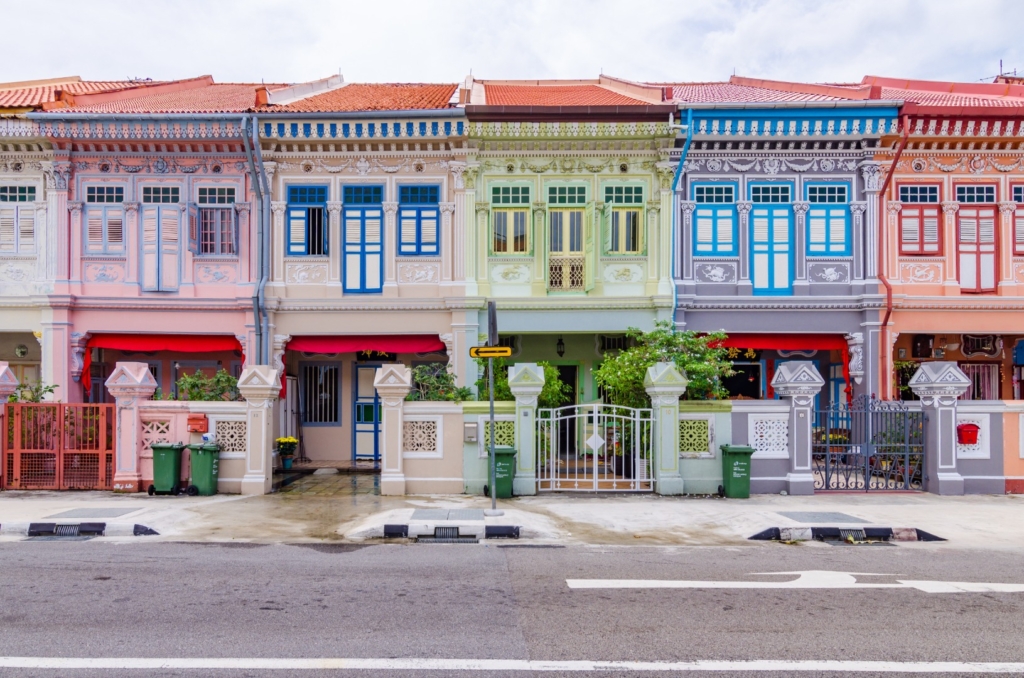
There is one place. The place where you can find Rococo style shophouses continuing to be built well into the 1930s is on the East Coast. The enclave of streets laid out between Joo Chiat Road and Still Road (Koon Seng Road, Everitt Road). Furthermore, they contain many fine examples of late 1920s and 1930s terrace houses in a range of contemporary style. Such as Neo-Classical, Peranakan, Rococo with a dash of Chinoiserie. For the most part, the style is quieter than the full-on Rococo found in Little India. Source: Nathalie LAOUE
Singapore Conservation Programme
The Urban Redevelopment Authority (URA) is the national planning authority for Singapore. Its active involvement in conservation started as early as the 1970s. In addition, with the rehabilitation of some state-owned properties for adaptive reuse. To date, conservation status has been given to 94 conservation areas involving over 7000 buildings throughout the island. Conservation of our built heritage is an integral part of urban planning and development in Singapore. The restoration of our historic areas add variety to our streetscapes and modulate the scale of our urban fabric. Hence, creating the visual contrast and excitement within the city while protecting the important reminders and representations of our past. In addition, it adds to the distinctive character and identity of our city. Thus, giving it a sense of history and memory of place.
Historic Districts
History Of Shophouses: The Historic Districts of Boat Quay, Chinatown, Kampong Glam, and Little India characterized by predominantly two- and three-storey shophouses. Also, ranging from the Early Shophouse Style to the Art Deco Shophouse Style.
1.Boat Quay
The Boat Quay Historic District, bounded by South Bridge Road, Circular Road, Lorong Telok, and North Canal Road. In fact, it was traditionally the centre of trading activities along the Singapore River. Located next to the Downtown Core. Its shophouses and warehouses, which lined the river, give it a unique charm and character. Today, it is an area with predominantly commercial premises of retail and eating establishments.
2.History Of Shophouses: Chinatown
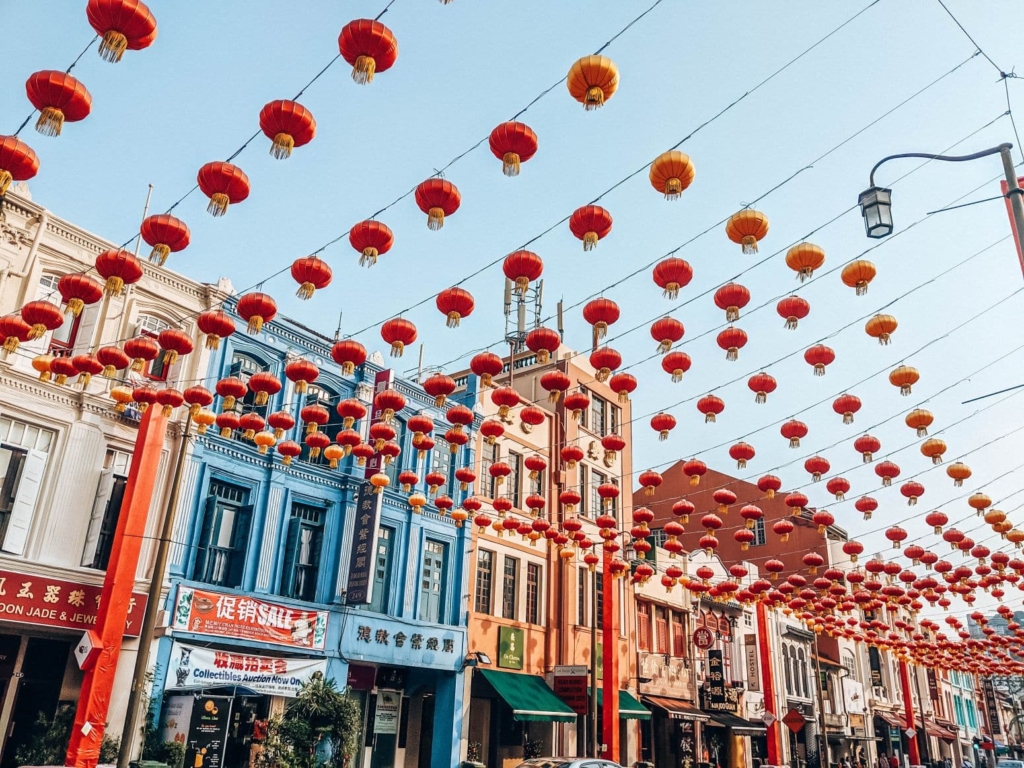
The Chinatown Historic District, located south of the Singapore River, is the original settlement of the Chinese community in Singapore. It is a largely intact area of shophouses with original texture and fabric. Depicting the simple lifestyles of the early immigrant community. The District comprises 4 subdistricts, each with a distinctive character. They are:
- Kreta Ayer. Bounded by New Bridge Road, Park Road, Upper Cross Street, South Bridge Road, Sago Street, Trengganu Street, and Smith Street. Known for its bustling street atmosphere and festive events.
- Telok Ayer. For example, bounded by South Bridge Road, Cross Street, Boon Tat Street, Stanley Street. Also, McCallum Street, Amoy Street, Ann Siang Road, and Erskine Road. Associated with long rows of shophouses and religious buildings along Telok Ayer Street. And, hilly residential and clubhouses at Ann Siang Hill.
- Bukit Pasoh. Bounded by New Bridge Road, Keong Saik Road, Kreta Ayer Road, Neil Road, and Cantonment Road. It provides the setting for a mixture of residential, association, and commercial activities.
- Tanjong Pagar. Bounded by Neil Road, Maxwell Road, Peck Seah Street, Wallich Street, Tanjong Pagar Road, and Craig Road. It features winding streets and a mixture of residential and commercial activities.
There are altogether five national monuments within the Chinatown Historic District. They are the Sri Mariamman Temple and Jamae Mosque in Kreta Ayer. Also, the Thian Hock Keng Temple, Nagore Durgha Shrine and Al-Abrar
Mosque in Telok Ayer.
3.Kampong Glam
The Kampong Glam Historic District, for example, bounded by Ophir Road, Victoria Street, Jalan Sultan, and Beach Road. Besides, it was traditionally a Malay residential area with ethnic-based activities at the periphery and along Arab Street. Its unique character lies in the contrast between its streetscape. With its low and uniform scale, and the large open spaces of the palace grounds. It is largely an area of shophouses with original texture and fabric. The presence and influence of the Arabs in the early 1910s registered by the names allocated to its streets. The Sultan Mosque and the Istana Kampong Gelam, both national monuments, are located within the Kampong Glam Historic District.
4.History Of Shophouses: Little India
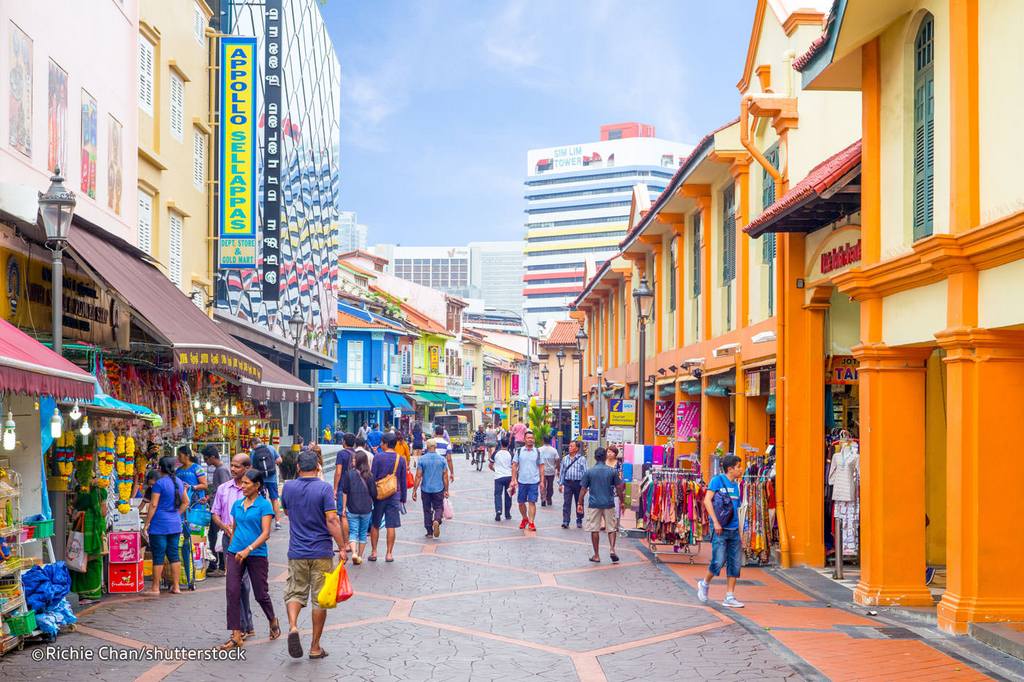
The Little India Historic District, bounded by Serangoon Road, Sungei Road, and Jalan Besar. It recognized as the hub of Indian community life in Singapore. Besides, it well patronized by local Indians and people of other ethnic origins, and Indians from abroad. Moreover, it was once used for agriculture and later for the cattle trade. The District’s historical value lies in its rich variety of buildings, streetscapes. Also, the urban texture of its main streets, side roads, back lanes, and open spaces. Most of its built fabric of the late 19th century or early 20th century is still largely intact. The Abdul Gaffoor Mosque, a national monument, is located within the Little India Historic District.
The NUS ‘Baba House’: Richness of Straits-Chinese Architecture Restored
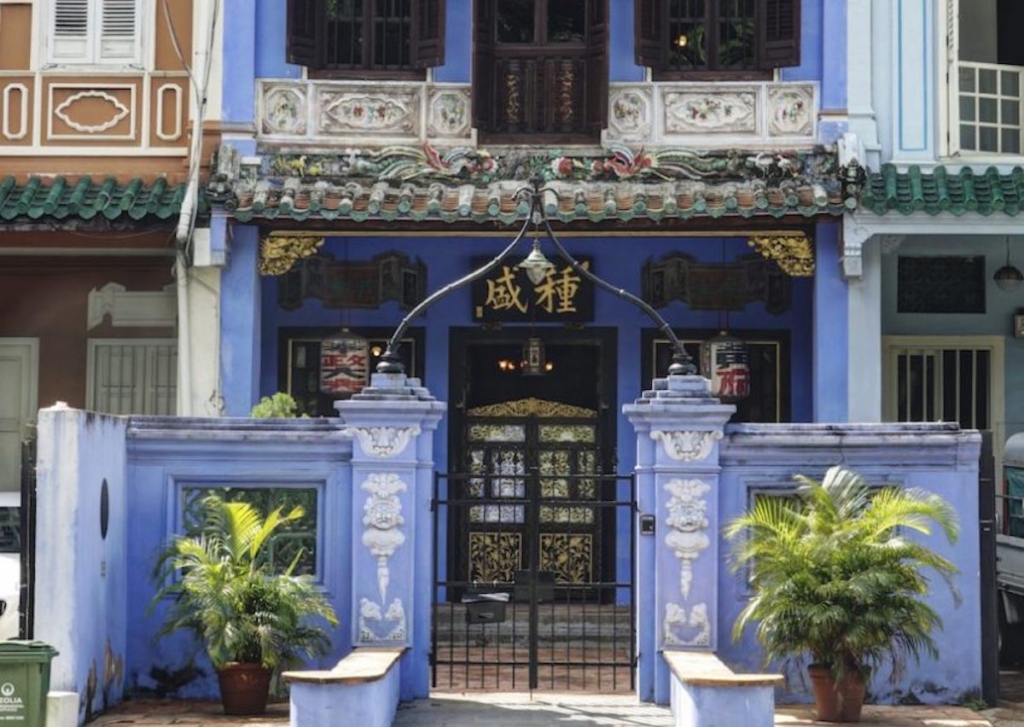
Once the ancestral home of a Straits-Chinese family, the NUS ‘Baba House’ located at No. 157 Neil Road. It is an example of an architectural beauty that has been carefully restored by the URA. Hence, it illustrates conservation best practices. It is one of the last few untouched Straits-Chinese Houses in Singapore. Not only has its façade been revived with original ornamental details. Besides, the restoration also showcases the 1920s domestic culture of the Straits Chinese community in Singapore.
Welcoming visitors to the Baba House are the wooden half doors or pintu pagar. It is a typical cross-cultural feature that used to be common in Singapore’s historic residences. The main hall features elaborate and intricately carved structures of floor to ceiling screens and partitions. The Baba House is representative of the visual interest that a well-restored shophouse can provide to our urban landscape. And at the same time, remind us how these shophouses are representative of Singapore’s unique cultures and aesthetic tastes.


